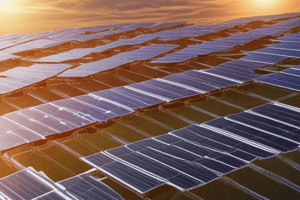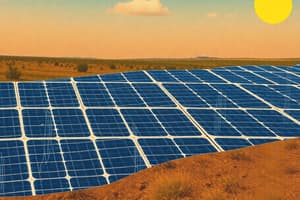Podcast
Questions and Answers
What do photovoltaic cells do?
What do photovoltaic cells do?
Convert sunlight into electrical energy through the photovoltaic effect
Which of the following are types of photovoltaic cells? (Select all that apply)
Which of the following are types of photovoltaic cells? (Select all that apply)
- Polycrystalline Silicon Cells (correct)
- Organic Photovoltaic Cells (correct)
- Thin-Film Cells (correct)
- Monocrystalline Silicon Cells (correct)
What is the typical efficiency range for photovoltaic cells?
What is the typical efficiency range for photovoltaic cells?
15-20%
What is the voltage typically produced by a photovoltaic cell?
What is the voltage typically produced by a photovoltaic cell?
What is a disadvantage of photovoltaic cells?
What is a disadvantage of photovoltaic cells?
An inverter converts DC power into ______ power.
An inverter converts DC power into ______ power.
Photovoltaic cells have many moving parts that require maintenance.
Photovoltaic cells have many moving parts that require maintenance.
What is one characteristic that depends on the amount of sunlight and cell size?
What is one characteristic that depends on the amount of sunlight and cell size?
What are the two main types of photovoltaic cells?
What are the two main types of photovoltaic cells?
What is the efficiency range of photovoltaic cells?
What is the efficiency range of photovoltaic cells?
Solar panels convert sunlight into AC electrical energy.
Solar panels convert sunlight into AC electrical energy.
Which factors affect the efficiency of solar panels?
Which factors affect the efficiency of solar panels?
Name two types of energy storage systems.
Name two types of energy storage systems.
Solar energy is considered a __________ energy source.
Solar energy is considered a __________ energy source.
What are the applications of solar thermal systems?
What are the applications of solar thermal systems?
Biomass energy is a non-renewable energy source.
Biomass energy is a non-renewable energy source.
Match the following energy storage systems with their characteristics:
Match the following energy storage systems with their characteristics:
Flashcards are hidden until you start studying
Study Notes
Photovoltaic Cells
What are Photovoltaic Cells?
- Convert sunlight into electrical energy through the photovoltaic effect
- Also known as solar cells
How do Photovoltaic Cells Work?
- Light Absorption: Photons from sunlight hit the photovoltaic cell, exciting electrons in the material
- Electron Flow: Excited electrons flow through the material, creating an electrical current
- DC Power Generation: The flow of electrons generates direct current (DC) power
- Inverter Conversion: An inverter converts the DC power into alternating current (AC) power, usable in homes and businesses
Types of Photovoltaic Cells
- Monocrystalline Silicon Cells: Most efficient, but also most expensive
- Polycrystalline Silicon Cells: Less efficient, but less expensive
- Thin-Film Cells: Cheapest, but least efficient
- Organic Photovoltaic Cells: Made from organic materials, potentially cheaper and more flexible
Characteristics of Photovoltaic Cells
- Efficiency: Measures how much sunlight is converted into electricity (typically 15-20%)
- Voltage: Typically around 0.5-0.6 volts per cell
- Current: Depends on the amount of sunlight and cell size
- Power Rating: Measured in watts (W), typically ranging from a few W to hundreds of W
Advantages of Photovoltaic Cells
- Renewable Energy Source: Sustainable and non-polluting
- Low Maintenance: No moving parts, long lifespan (up to 30 years)
- Scalability: Can be used for small-scale or large-scale power generation
Challenges and Limitations of Photovoltaic Cells
- Intermittent Energy Source: Energy generation depends on sunlight availability
- High Upfront Cost: Although decreasing, still more expensive than traditional energy sources
- Energy Storage: Requires energy storage solutions for nighttime or low-sunlight periods
Overview of Photovoltaic Cells
- Photovoltaic cells, also known as solar cells, convert sunlight into electrical energy through the photovoltaic effect.
Functionality of Photovoltaic Cells
- Light Absorption: Sunlight photons excite electrons within the cell material.
- Electron Flow: The movement of excited electrons generates an electrical current.
- DC Power Generation: Flow of electrons creates direct current (DC) electricity.
- Inverter Role: An inverter transforms DC power into alternating current (AC) power for practical use.
Types of Photovoltaic Cells
- Monocrystalline Silicon Cells: Most efficient solar cells, but have a higher cost.
- Polycrystalline Silicon Cells: Lower efficiency compared to monocrystalline, but more affordable.
- Thin-Film Cells: Economical option with the least efficiency among the types.
- Organic Photovoltaic Cells: Made from organic materials, potentially cheaper and more versatile in use.
Characteristics of Photovoltaic Cells
- Efficiency: Generally ranges from 15% to 20% in converting sunlight to electricity.
- Voltage: Each cell typically produces about 0.5 to 0.6 volts.
- Current: Varies based on sunlight intensity and the size of the cells.
- Power Rating: Measured in watts (W), typically from a few watts to hundreds of watts.
Advantages of Photovoltaic Cells
- Renewable Energy Source: Sustainable and environmentally friendly, producing no pollution.
- Low Maintenance: Feature no moving parts, offering a long operational lifespan (up to 30 years).
- Scalability: Suitable for both small-scale personal use and large-scale power plants.
Challenges and Limitations of Photovoltaic Cells
- Intermittent Energy Source: Energy production is reliant on direct sunlight availability.
- High Upfront Cost: Initial investments remain substantial, though prices are declining.
- Energy Storage Requirement: Necessitates storage solutions for energy during non-sunny periods or nighttime.
Photovoltaic Cells
- Convert sunlight into electrical energy via the photovoltaic effect.
- Constructed from semiconducting materials, predominantly silicon.
- Comprise multiple layers, each with distinct electrical properties.
- Two primary types:
- Monocrystalline silicon cells: exhibit high efficiency and carry a higher cost.
- Polycrystalline silicon cells: offer lower efficiency at a more affordable price.
- Efficiency varies between 15% and 22%.
Solar Panels
- Assemblages of photovoltaic cells that are electrically interconnected and mounted on a supporting frame.
- Transform sunlight into direct current (DC) electrical energy.
- Performance rated by peak power output (Wp) under standardized testing conditions.
- Efficiency impacted by factors such as:
- Temperature variations
- Proximity to shading
- Angle of sunlight incidence
- Utilized in diverse applications including:
- Residential setups
- Commercial installations
- Industrial uses
- Utility-scale power generation
Renewable Energy Sources
- Solar energy classified as a renewable energy source, signifying its continual replenishment.
- Other renewable sources include:
- Wind energy
- Hydropower
- Geothermal energy
- Biomass energy
- Essential characteristics entail:
- Sustainability and renewable nature
- Non-depletable resources
- Minimal greenhouse gas emissions
- Abundant availability
Energy Storage Systems
- Enhance efficient and reliable utilization of solar energy.
- Varieties of energy storage include:
- Battery systems, such as lithium-ion batteries
- Pumped hydro storage systems
- Compressed air energy storage solutions
- Flywheel energy storage technology
- Key functionalities encompass:
- Mitigating output variability
- Offering backup energy during grid outages
- Optimizing energy consumption and minimizing peak loading demands
Solar Thermal Systems
- Employ mirrors or lenses to concentrate sunlight and heat a working fluid.
- Applications extend to:
- Heating water for domestic use
- Providing space heating
- Supporting cooling systems
- Facilitating various industrial processes
- Types of systems include:
- Parabolic trough systems
- Solar tower designs
- Dish-Stirling technology
- Linear Fresnel reflector systems
- Advantages include:
- High efficiency levels
- Scalability for various needs
- Capability to deliver dispatchable power when required
Studying That Suits You
Use AI to generate personalized quizzes and flashcards to suit your learning preferences.




